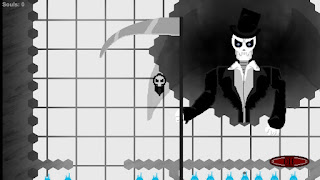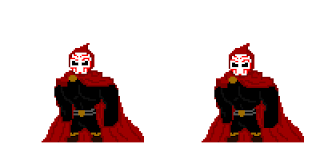ART 381
Wednesday, May 4, 2016
Project 3
Project 2
SHY GUY SURPRISE
My team and I cranked out some great work on this project.
The concept is that you are in a real-life Mario Party minigame that addresses the issues behind bullying and school shootings.
Bowser is the bully, pushing the perpetrators (Shy Guy) to the brink of shooting innocent bystanders (Princesses, Mario Bros, and Toads).
Every bystander that got shot was to stay in place, and hold up a Boo, to show that they had been killed.
The Dead Toad prop was just to drive the idea home and make it a little more grim, even when the players were having fun.
The Shy Guy mask needed to have lenses, because the shooters should feel completely unknown and unseen as they take pleasure in outing their friends playing as bystanders.
It was an absolute pleasure working with Emma, Becca, and Christian on this project. Thanks for the good time, guys.
Project 1
Project one was a nightmare.
The game was called "Forbidden Desert"
We updated to "Political Storm"
The idea is that you get political standing and try to get off of the board and into the White House before the board gets covered with propaganda and you consequently die.
Artwork, assembly and printing were my job. I created player cards exclusively and many of the flip over tiles. I made the storm level counter as well.
I reworked my partner's artwork because he was rough in Photoshop, stayed up all night printing, and used a great deal of my own expensive resources to make the game feel and look more professional.
My father and Cousin helped me out a great deal with assembly of tiles and cards that had thicker backing.
Artist Lecture, Kenyon
Art 381
Mitch Murway
Artist Lecture – Matt Kenyon
Matt Kenyon is a multimedia artist with some very interesting ideas and political / socioeconomic statements to make. I really enjoy the idea of not hating the media, just becoming it. It raises a great point that if those of us that hated the media became directors and employees in the media, then the media would change for the better.
In his piece, Spore he makes a great statement about the economic bubble burst through a house plant that either “lives” or “dies” based on data being fed to the apparatus that waters the plant based on Home Depot stock shift. Very compelling, and clearly stated… the entire country runs as this machine does…it’s just a beautiful and ingenious way of displaying the concept in a very simple form.
Much like that statement and method made by “Clouds” where he uses imagery of clouds made from foam that take data used from the housing market, which also bubbled and burst heavily around the recession, in the Gallery, on the ceiling you see projections of houses, and as they lose their value or buoyancy they become dilapidated and foul looking. Again, another very good and simple representation of a concept many people fail to grasp in our dying economy.
My last thought on a piece by Kenyon is about Puddle, which was a piece that really spoke volumes as well (most of Kenyon’s work is remarkably communicative).
A puddle of black oil, that displays the names of car models that cause massive carbon footprints as you approach it. Multidimensional artwork that actually kind of speaks to a Monet inspiration of anti-aesthetic while also making a bold statement that adds to a sort of intellectual beauty.
Overall, Kenyon is just a pretty remarkable artist, and his influence may actually make a difference in how future artists sway opinions of the public.
NV Museum Exhibit
Mitch Murway
Art 381
Exhibit WriteUp
Nevada Museum of Art
The Beautification Machine was a very strange exhibit. The multimedia presentation was a bit odd to me. I like to go into an exhibit without the artist statement first, and then approach it a second time after reading the artist’s interpretation. However, my method nearly destroyed this presentation for me. I approached the curtain, pulled it back and immediately felt like walking into a cult brainwashing room with people sitting and surrounding the obelisk in the center of the room. I thought for a moment that it would be pretty killer as a hookah and people could be having a good time with it. (ha)
After observing the construction for about 15 minutes, I observed what was coming out of the obelisk itself and then I stepped out for a read of the artist statement.
My secondary evaluation of the project was that it looked like an interpretation of what the news, advertising, and popular media were doing to our perception in high load situations, fragmenting everything we see without allowing for a true focal point.
After reading the artist statement, unfortunately I was disappointed to know that it was simply a method by which the artist was trying to make something beautiful from something as terrible and manipulative as the news and media. The audio was fragmented just as well as the images of the news clips…and played through speakers underneath the obelisk that were in vintage cabinet housing. The obelisk itself was made of many different panels of warped and two-way mirrors, glass and fogged plastic with news scenes being projected into a disco ball that rotated on a shaft that ran to a small electric motor underneath. This created a very kaleidoscope effect on the images directly above the obelisk and disjointed and disturbed images all over the walls. I personally think that the objective was short sited, but I was also impressed that the artist came out with something as unique as this with such a simple goal.
Black Rock Press Lecture and Exhibit
Mitch Murway
Art 381
Artist Lecture
Black Rock Press - Jaime Lynn Schafer
The lecture at Black Rock press was very intriguing. I found it rather odd to know that people are still working in printmaking mediums like these…and at first I was a bit confused as to why someone would put themselves in that position, rather than use Photoshop, but I realized rather quickly that the artist’s passion comes through with a more textured and 3D presentation of her vision. Schafer had a pretty wide background, which I found interesting in that she ended up at UNR completing her BFA. I still have a hard time grasping UNR as anything other than the local University.
She gave a lot of information on her former work and jobs, but the real interesting bits emerged in her presentation of the art in the exhibit, and told the stories behind them.
The first project that she presented was the one that really caught my attention, because she was a Pennsylvania native, she chose to make a three-dimensional art booklet on the topic of Centralia, PA. I’d done research on Centralia before so I knew immediately what she was talking about. The town is a very interesting case study in USA history, and yet it’s considered obscure knowledge by most. Centralia was a mining town in PA, before it’s city officials decided it would be a good idea to light their landfill on fire to consolidate that trash into a smaller mass. After they lit the fire, a coal vein that was exposed underneath the landfill caught fire and has been burning for over 60 years. The part that she didn’t quite elaborate on is the fact that the coal is andecite coal, which burns much longer and much hotter. The burning coal beneath the city made for noxious gas emissions that were very poisonous, and sink holes that were popping up randomly. The real reason that it’s a ghost town is the fact that one of those sink holes swallowed a kid in his backyard and the noxious fumes nearly killed him…so the US govt. relocated the citizens of Centralia. The city attempted to install large heat vents and risers in the streets to redirect the fire, they even dumped god-awful amounts of water into the mines and the fire still raged on. Her book was very interesting…all layers of the “hole” were black and white, aside from the final page, which was all colors of fire. I thought it was really magnificent.
EXHIBIT
The lecture doubled as an exhibit, and so I wanted to separate the topic of the rest of her artwork as a subject of it’s own. There were two other examples of artwork that really struck me in the exhibit, aside from the piece on Centralia. RED was a book with a great deal of meaning. When Schafer’s wife was teaching at a school in Sparks, there was a code red lockdown situation meaning that there was an active shooter in the school. Students and faculty aren’t supposed to text or use phones during a red alert, but she sent a text to her wife saying that there was an active shooter lockdown and that she would be ok. This triggered the inspiration for RED, which is a book with brick pattern printed beautifully on the outside, while the inside unfolds like walls of a building, the walls have silhouettes of victims and shooters printed on them, as well as disjointed trigger words associated with school shootings.
The last piece that really resonated with me was a brochure format book that was Coyote tan with blue trail lines all over it, and topographic featuring (2D) that was documenting the route and history of Geiger Grade, as well as it’s historic significance. I really liked the piece, until the artist said that she had taken artistic liberties with the visuals involved in the piece. This was mildly disappointing, but then I remembered that it is indeed art, and not a documentary piece being submitted for consideration with a museum of any sort, so I returned to admiring her work and interest in Nevada’s rich history.
Subscribe to:
Comments (Atom)


























